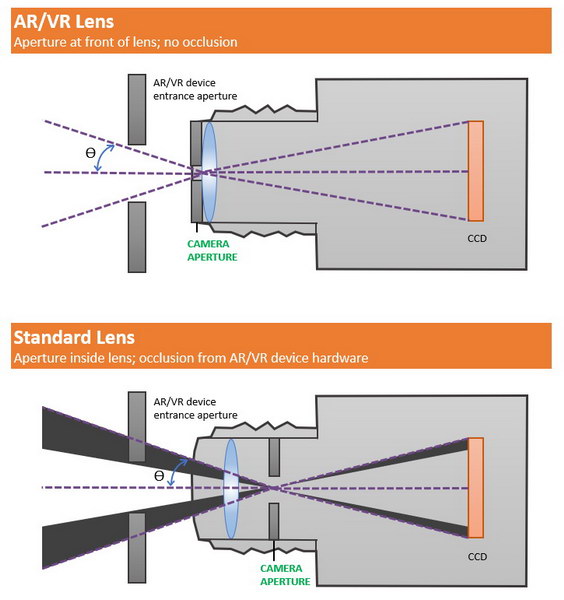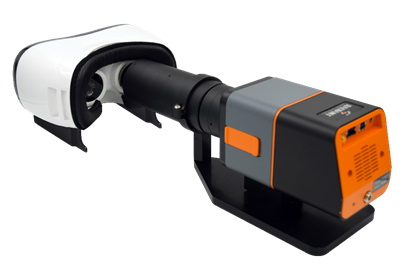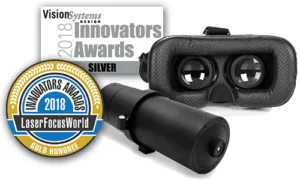Radiant Vision recently received a Gold Innovation Award from Laser Focus World for its lens designed to facilitate testing of near-eye displays (NEDs) such as AR and VR head-mounted displays. Currently there are no standards for the measurement of NEDs but the Society for Information Display (SID), sponsor of the International Committee for Display Metrology (ICDM) is working on development of a method to include in the next version of the Information Display Measurements Standard (IDMS). The International Electrotechnical Commission (IEC) Technical Committee 110 WG ADH-12 is also currently circulating a NED measurement standard and the ICDM is working with the IEC to ensure both organizations provide similar NED measurement systems.
 The Radiant Vision AR/VR lens (top) mounted on an imaging colorimeter radiometer evaluating a HMD. A conventional camera lens (bottom) would have unacceptable vignetting if used to measure a HMD. (Credit Radiant Vision)
The Radiant Vision AR/VR lens (top) mounted on an imaging colorimeter radiometer evaluating a HMD. A conventional camera lens (bottom) would have unacceptable vignetting if used to measure a HMD. (Credit Radiant Vision)
The optical properties of a NED cannot be properly evaluated with a conventional lens, such as the ones used to measure direct view LCD, LED videowalls or projection systems. Instead a lens with optical properties essentially identical to the properties of the human eye is required. Three of the key optical properties of a lens to properly evaluate NEDs are lens pupil diameter, lens pupil position and field of view. In addition, the mechanical design of the lens and the imaging photometer it is mounted on must allow the pupil of the lens to be placed in the same pupil location as a human eye’s pupil when a person is wearing the HMD.
The AR/VR lens from Radiant Vision Systems is designed to meet these requirements, as shown in the image. Note that in this case, the pupil location in the lens is in front of the first element. With a standard camera or measurement lens, the aperture is typically placed behind the first lens element. This leads to vignetting and results not representative of what a human eye would see, especially at the periphery of the field of view of the HMD. This lens will fit on the ProMetric I-series Imaging Colorimeters, as shown, or the ProMetric Y-series Imaging Photometers.
 The Radiant Vision AR/VR lens mounted on their ProMetric I Imaging Colorimeter evaluating a HMD. (Credit Radiant Vision)
The Radiant Vision AR/VR lens mounted on their ProMetric I Imaging Colorimeter evaluating a HMD. (Credit Radiant Vision)
The AR/VR lens has a FOV of 120° horizontally, approximately matching the FOV of the human eye. Wide FOV lenses always have distortion associated with them so each of the AR/VR lenses comes factory-calibrated to correct for this distortion. In the human eye, the eye/brain combination automatically corrects for this distortion.
Radian Vision also provides its ProMetric software to go with the HMD measurement system which includes the AR/VR lens combined with an imaging photometer or colorimeter. This software evaluates properties such as color and brightness uniformity of the HMD. It will also interface to external control software to allow construction of automated inspection systems. –Matthew Brennesholtz

